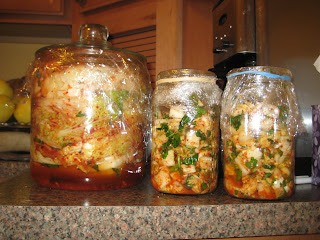
As I was cleaning out the last of the fall debris from my garden a few weeks ago, I thought some of my sturdy wax begonias might look nice in a vase. I cut off twenty stems and displayed them in a low, narrow glass container, to good effect. The coppery leaves looked excellent with some rust colored candles I had picked up at a craft fair. I was pleased to have pink flowers gracing my Thanksgiving season table, refreshingly delicate when compared with the usual wheat-and-maple leaf cornucopias. I am not a very good caretaker of cut flowers, and I went about my life, ignoring the little flowers that were thriving away in the light of a southern window. I realized this morning they had roots. I had inadvertently created a nice collection of new begonia plants from my cuttings.
Wax begonias belong to that dubious category of plants recommended for "children and new gardeners". As soon as I read a phrase like this, the snob in me wants to reject these begonias out of hand. But then I remind myself that I have a child and I am a (fairly) new gardener. Sigh. This year, I am still going to try my hand at more sophisticated projects, like growing hellebore from seed. But wax begonias have their place: they are cheap, easy to grow, and look nice in a shady patch in my garden. And my child does love them.
Several writers also note that this is plant is a "classic choice" for apartment buildings and gas stations, much like my beloved and oft-maligned dusty millers. Instantly, I can conjure the image of sorry little begonia plants spaced too far away from each other, arranged in too regular of a pattern, and surrounded by a pile of dyed-red wood mulch. Not really the ambiance one is looking to create in a backyard oasis. To avoid this, I am going to change over to container plantings this upcoming year, and stagger them around the shady spots of my garden. If they still reference a gas station, so be it! I am an urban homesteader after all.
As for those containers, I guess I have a head start. We'll see if I can successfully overwinter these new cuttings. If I can't, I know there will be large, well-priced flats for sale at even the most basic nurseries. Gas station owners need to shop somewhere, too!














